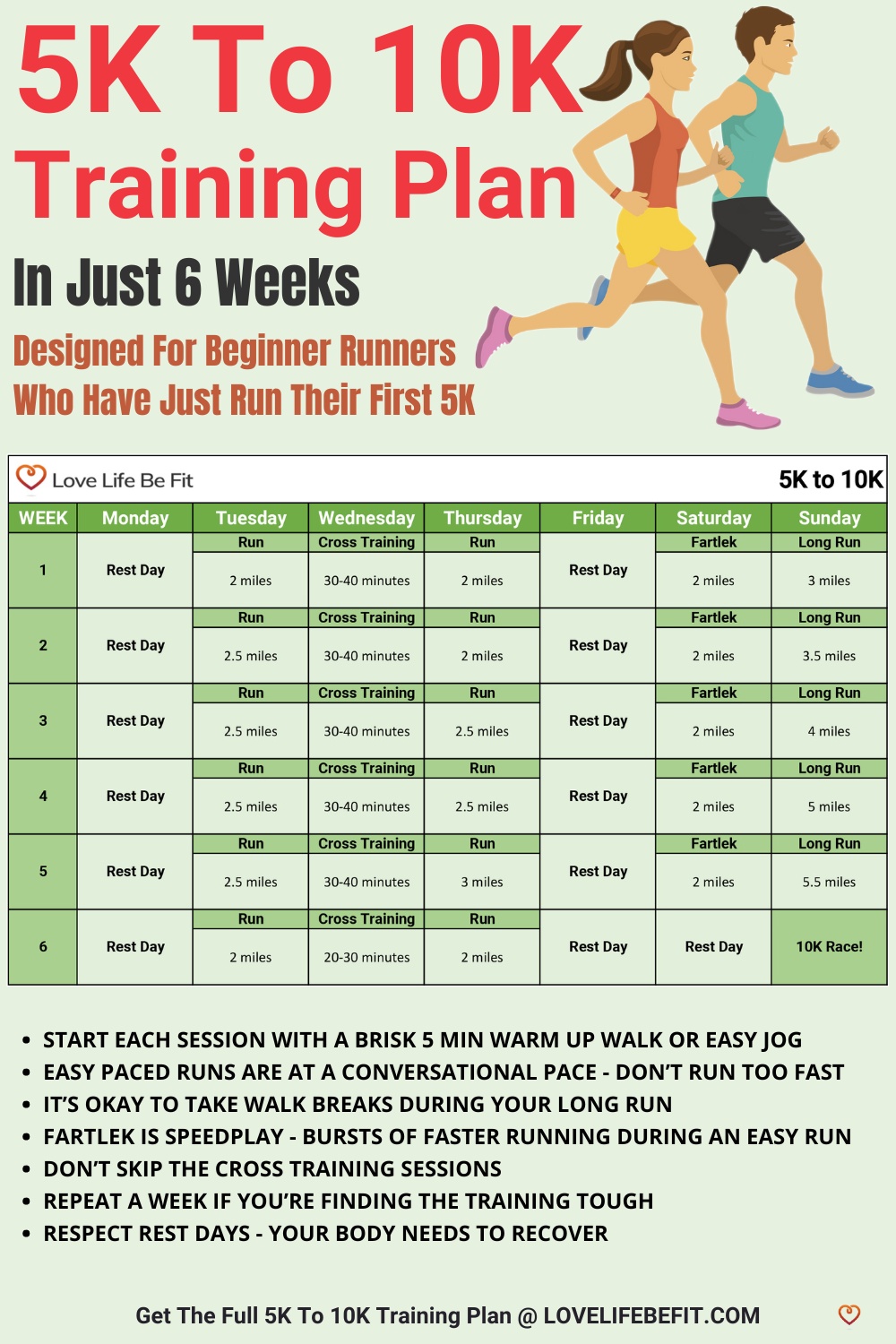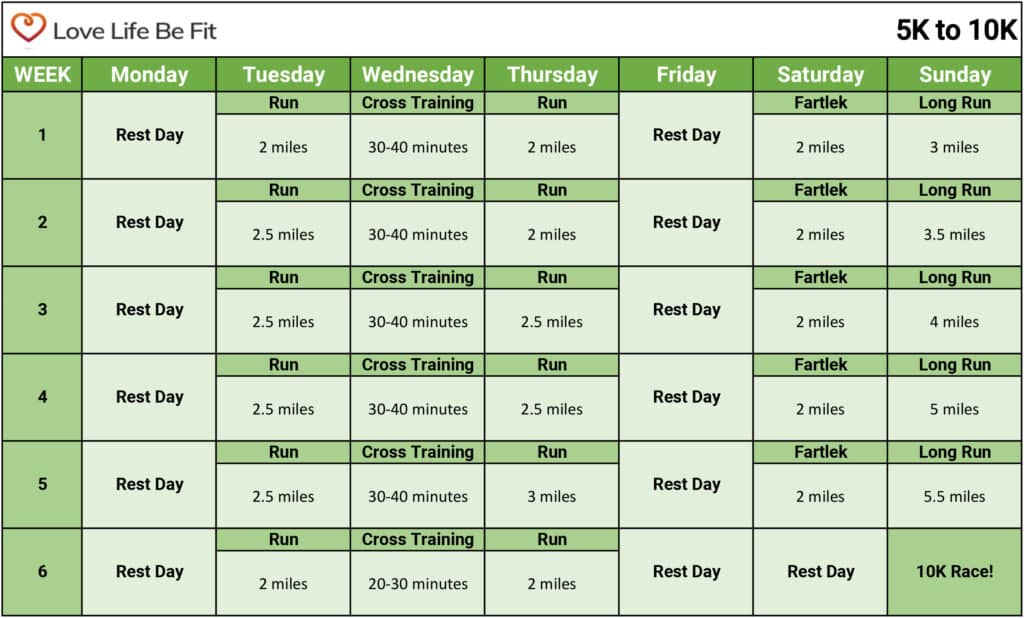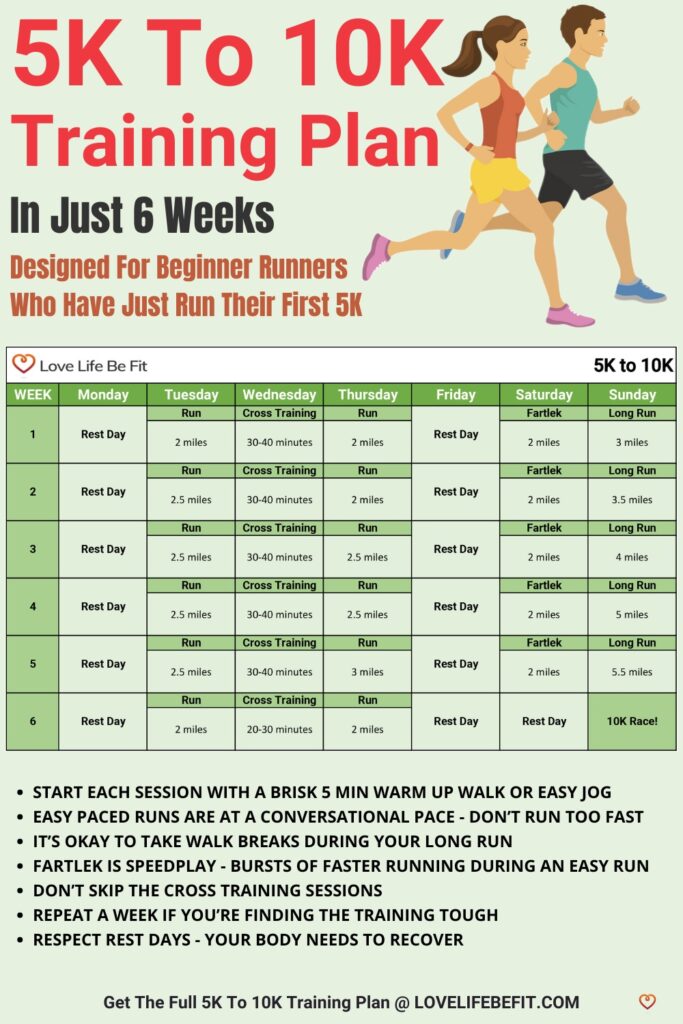5K To 10K Training Plan: Beginner Running Schedule
Just completed your first 5K race? Looking for your next challenge? A 10K is the next step up in distance. This 5K to 10K training plan is designed to help a beginner runner complete the longer distance without risk of injury.
5K to 10K may seem like a big jump – of course, it’s double the distance, but you’ve already done the hard work by making the effort and time commitment to become a new runner.
If you can already run 5K continuously, this training schedule is for you. The focus is on gradually increasing the length of your long runs and adding your first speed sessions to improve your leg turnover. The aim is to turn you into a stronger runner ready for your 10K race.

Are You Ready For 10K?
New runners are always prone to injury. I’m a strong believer that running is good for you but it’s easy to come unstuck. It’s just so tempting to go too hard, too soon.
If you’ve just completed a Couch to 5K plan but mainly ended up walking around the route, it’s too soon to step up to the 10K distance.
Instead, go back and repeat the last 3 to 4 weeks of your Couch to 5K plan until you’re running consistently.
When you can run 5K without a walk break – jogging is fine and it’s okay to be a slow runner – you’re ready for this 5k to 10k training plan.

5K To 10K Training Plan
The 5K to 10K training plan is a big commitment. You’ll be training 5 days of the week and building up from a running distance of 9 miles a week to running a maximum of 13 miles a week.
On top of that, there’s one session a week of cross-training – don’t skip this! You can choose to cycle, swim, take a yoga class – anything you enjoy that will complement your running.
Plus it’s beneficial to add two short strength training sessions per week after your mid-week easy runs.
The plan includes rest days. Your two rest days a week are very important. New runners need to recover!
Here’s the structure of your weekly training cycle:
- 2 mid-week easy training runs
- 1 long run at the weekend
- 1 fartlek speed session
- 1 cross-training session
Plus 2 short strength training sessions of about 15 minutes after your shorter runs.
How long the training sessions take each week will of course depend on how fast you run but expect to exercise for around 190 to 265 minutes per week. (About 3 to 4.5 hours).

Running Days
Start each running session with a warm up. I recommend some dynamic stretching exercises followed by 5 minutes of brisk walking or a slow jog. Allow enough time to warm up your muscles properly.
Dynamic stretches are movements that take your joints and muscles through their full range of motion.
They fire up the nervous system, improve your running economy, and help prevent injuries. You can also include some warm-up drills – my favorite is monster walks!
Easy Pace
Apart from the fartlek session, all of your runs will be at an easy pace. That’s a Rating of Perceived Exertion (RPE) of 3 to 4. You will be running at a conversational pace – able to talk and run at the same time. It’s a much slower pace than your 5K race time.
At this stage of your running experience, it’s important to slowly build your strength as a runner, running longer without getting tired. You’re working muscles that are still new to running and it takes time to build a good base.
But even experienced runners tend to follow the 80/20 rule of training – where 80% of runs are at an easy run pace and just 20% of running workouts are hard efforts.
Long Run Day
Your weekly long run will gradually increase in distance. It’s a key session in your 5k to 10k training plan. The long run day slowly builds your endurance and stamina – allowing you to cover the 10K distance on race day.
Your longest run before your 10K race is 5.5 miles – almost the distance you’ll cover on in your race.
Speed Workouts
This 5k to 10k training plan aims to get you around the course running continuously. It’s not a plan for producing fast times, it’s a plan for beginners to get you over the finish line.
Training for a fast 10K can come later – when you have a good running base and a strong runner’s body that’s resistant to injury. Training techniques such as interval training and tempo running are more appropriate for experienced runners.
However, the 5K to 10K plan does include a weekly 2-mile fartlek session to help you run faster.
Fartlek
It’s a Swedish word meaning speed play. The concept is simple – you add in some bursts of fast running during an otherwise easy run.
The beauty of fartlek training is that there are no rules. You simply use landmarks to guide your burst of speed – running to the next lamppost or tree, for example, before resuming your easy pace.
Fartlek training helps to increase your running speed and gets your legs turning over faster, improving your cadence. It’s a good way to improve your cardiovascular fitness.

Cross-Training
Adding in one cross-training session per week will help to reduce your risk of injury and keep you motivated. It will also complement your running by working different muscles.
Choose an activity that you enjoy and that’s not too demanding on your body. Swimming, cycling, rowing, and elliptical training are all excellent forms of cross-training for runners.
Just make sure the intensity level is easy to moderate. The intention is to enhance your training not leave you unable to complete your next run session.

Strength Training
Including 2 short strength sessions in your 5k to 10k training plan will improve your running economy and help to prevent injuries.
You don’t need to spend hours in the gym lifting weights. Just 15 minutes, 2 times per week, of bodyweight exercises is enough to see benefits. It’s best to fit the sessions in directly after your mid-week easy runs.
Try yoga for runners or specific bodyweight exercises for runners. Split squats, lunges, side planks, and glute bridges are all excellent exercises for runners.

Rest & Recovery
Rest days are just as important as training when you’re trying to improve your running. It’s during periods of rest that your body adapts to the training stimulus and gets stronger. It’s a good idea to do as little as possible on rest days while your body is adapting to training.
This 5K to 10K plan includes 2 days of complete rest each week.
Tips For Following The 5K To 10K Training Plan
Training plans are not set in stone. They’re merely a guide to help you structure your training. The key is to be flexible and to listen to your body.
Pick A Goal Race
It’s always easier to train if you have a target to aim for. Choose a 10K race that’s 6 weeks away and commit to training for it.
Once you’ve entered, put the date in your diary – it’s a huge motivator!
Repeat Weeks
If you need extra rest days or want to repeat a week before increasing your running distance – go ahead. Adjust the plan to suit your lifestyle. You can do your long run during the week and shorter easy runs at the weekend. Just try not to skip too many sessions.
Don’t Stress About A Goal Pace
It can help to have a goal race pace to make sure you don’t set off too fast – but the last thing you want to be doing mid-race is constantly checking your watch and target paces. You’ll just worry that you’re not running fast enough.
The aim is to finish comfortably. Your 10K finish time is less important. Training for a fast 10K can come later! Good luck and enjoy your race!
Related post: Tips for running your first 10K
Set Your Next Challenge
Successfully completed the 5K to 10K training plan? Finished your first race? It’s time to set your next fitness goal! Choose to run faster or further to become a better runner.
If you choose to go longer – take a look at my Couch to Half Marathon training plan. You can jump right in at the start of the third section – 10K to half marathon.
If you’ve followed this training plan I’d love to know how it went! I’m always looking to improve my plans and get feedback from beginner runners! Let me know in the comments below…

Running 101 Training Guides & Walking Schedules
5K Training Plans
- Couch To 5K Beginner Training Plan
- 12 Week 5K Training Plan
- 10 Week 5K Training Plan
- 8 Week 5K Training Plan
- 6 Week 5K Training Plan
- 4 Week 5K Training Plan
- 5K Training Plan Intermediate




